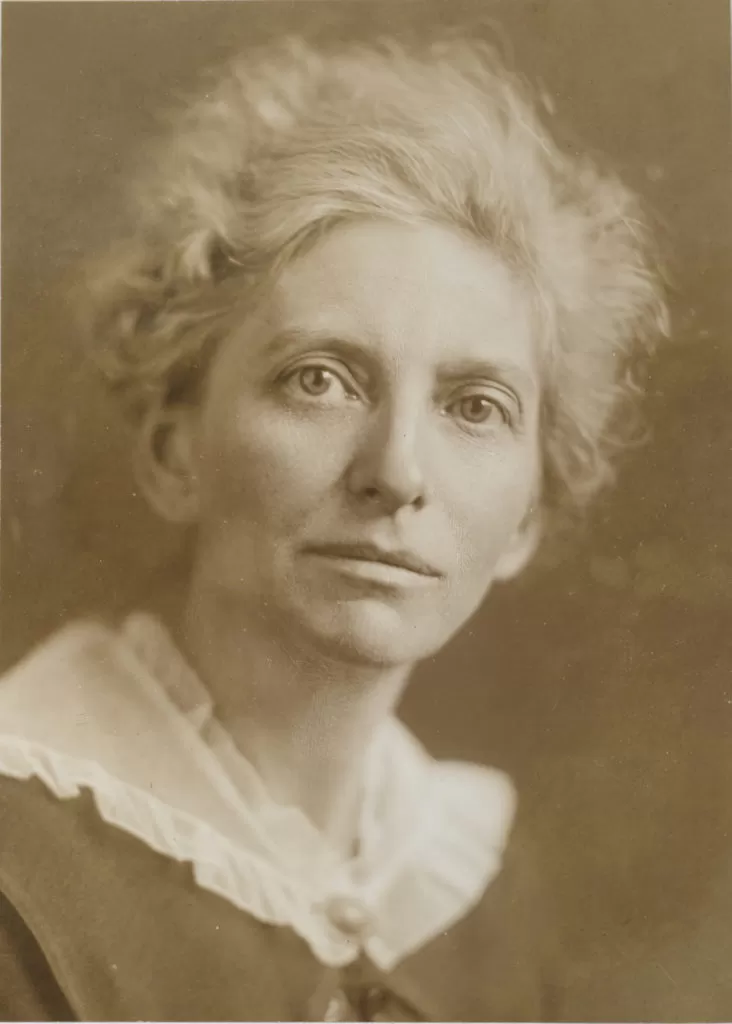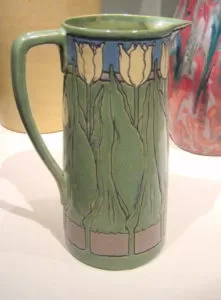The Saturday Evening Girls Club: A Story Worth Telling
by Kate Nixon

Saturday Evening Girls working in the Paul Revere Pottery in Boston. House Beautiful, June 1912.
The story of the Saturday Evening Girls is beloved: a story of turn of the century determination and an early example of immigrant women developing useful trade skills to make a career in America. This group of women turned a reading club into the beginnings of Paul Revere Pottery.
The Saturday Evening Girls Club was created in Boston, Massachusetts in 1899, the idea created from the minds of two women, Edith Brown and Edith Guerrier, a local librarian, who wanted to create a weekly club at first to discuss classic literature and for presentations of lectures from local figures. Due to the concern for young immigrant women without means to make their own living, the club turned into an opportunity for these young women to decorate pottery that would be sold and the resulting wages would support the young artists. Thus, a kiln and resources were purchased, an experienced potter was hired as an instructor to teach glazing and firing techniques, and the club that started in a settlement house was poised to become so much more. The club turned into a way of life and an essential community for young immigrant women daring to want for a better life. While the group’s members contained so many stories of women at the turn of the century, here are the stories of three of the standout women who contributed to this group of extraordinary artisans and supporters at the turn of the century.

Edith Guerrier, Brighton, Massachusetts. Chief of Library Section of Education Division. From the National Archives at College Park, MD.
Edith Guerrier
The local librarian of the North End Boston Public Library who set into motion the creation of Paul Revere Pottery, Edith Guerrier created a reading group who called themselves the Saturday Evening Girls in an attempt to provide opportunities for young immigrant women to fill a void in educational opportunities. The reading group would read plays, stories, classic literature, and listen to lectures on philosophy and political discourse. The weekly meetings would be attended by women coming from working-class Italian and Jewish immigrants living in crowded living conditions. After seeing artisanal wares in a European marketplace, Edith brought back the idea of decorating pottery back to her reading group in Boston and the Saturday Evening Girls would develop the skills needed to become an employee of Paul Revere Pottery.
Sara Galner

Paul Revere Pottery of the Saturday Evening Girls’ Club (United States (Massachusetts, Boston), 1907 – 1942) , Sara Galner (United States, 1894 – 1982) Pitcher, 1914 Ceramic, Earthenware, Height: 7 3/4 in. (19.69 cm); Diameter: 5 1/2 in. (13.97 cm) Gift of Max Palevsky to the Los Angeles County Museum of Art (AC1995.250.30)
The daughter of an immigrant Hungarian family, Sara took free folk dancing, sewing and cooking classes and attended the girls reading room of the North Bennet Street Industrial School, run by Edith Guerrier. Sara was recruited by Edith for her passion for knowledge, improvement, and reading. After graduating from required schooling, Sara would obtain a job as a department store stock girl and a dressmaker’s assistant. Learning skills in choosing color and quality materials added to her skillset – her skills were later developed as she enrolled in the Central Evening High School. She then sought out her friend Edith Guerrier where she decorated a few pots to pay her club dues in her club fees for the Saturday Evening Girls. Illustrator Edith Brown asked Sara to work full time. he then negotiated not only her own salary, but to increase the salary for the other girls to the same amount. Sara would decorate pots, vases and other works in the illustrations designed by Edith Brown, while her own talent was designing flowers on the ceramic works. Sara would continue to stand out as a decorator until the closing of Paul Revere Pottery in 1942. Sara went on to marry and have three children, but she stayed close with her SEG community.
Helen Osborne (Mrs. James T) Storrow
A Boston Philanthropist who financed the activities and expansion of the Saturday Evening Girls and later Paul Revere Pottery building, Helen Osborne Storrow was interested in the education and the empowerment of girls and the activities of the Saturday Evening Girls caught her eye. In addition to becoming an important financier of the club, Helen would participate in the different groups in the arts; she would create a summer camp in Wingaersheek Beach in West Gloucester, often exposing the young women to the outdoors and rural life. In 1908, Helen would purchase a large four-story building where the Saturday Evening Girls could make their wares and start their careers – and because the building was close to the path of Paul Revere’s famous ride, Helen decided on Paul Revere Pottery as their official name.
The Saturday Evening Girls/Paul Revere Pottery
The needs for the young potters-in-training grew and soon, the club moved from their small environment to a large 4-story brick building, due in part to the efforts of the pottery’s director Edith Brown and the support of Mrs. James J. Storrow, the firm’s official founders. The building was close to the route taken by Paul Revere on his famous ride – and so the pottery created and decorated from the building would bear his name. Paul Revere Pottery was continuously staffed by the members of the Saturday Evening Girls club, mostly girls just out of school. Within a year’s time, the young members would be skilled enough to take on the designing of the pottery, skills at an intermediate to advanced level. Storrow and Brown would expand again in 1915, this time the building would be modeled after the Rookwood factory and there were additional kilns, more employees were hired, and the variety of pottery items the girls would make grew to lamps, bookends, dinnerware sets and tiles, etc. Unfortunately due to ongoing expenses in the handcrafted decorating process, a lack of leadership after the passing of Edith Brown in 1932, and an economic depression, Paul Revere Pottery unfortunately closed its doors in 1942.
Resources:
The Official Price Guide to American Arts and Crafts by David Rago and Bruce Johnson, published by House of Collectibles, 2003. p. 122-123.
“The Story of the Saturday Evening Girls” by Nonie Gadsen, Carolyn and Peter Lynch Assistant Curator of Decorative Arts and Sculpture, Art of the Americas at the Museum of Fine Arts, Boston. Date of Publication: August 8th, 2013 in InCollect
https://www.incollect.com/articles/the-story-of-the-saturday-evening-girls
